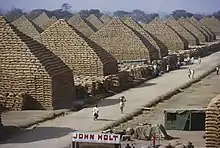
Groundnut pyramids were pyramid-like structures made from groundnut sacks. The pyramids were built in northern Nigerian cities such as Kano, where groundnut production was a key part of the economy. They were viewed as both a tourist attraction and a symbol of wealth. In the 1960s and 70s, as production in Nigeria shifted from agriculture to oil, the groundnut pyramids disappeared. Recently, the Nigerian government has made efforts to revive the groundnut industry and rebuild the pyramids.[1][2]
History
Groundnut pyramids were the invention of Alhassan Dantata, a prominent nut trader. Dantata came to Kano in 1919 and within five years was one of the most successful businessmen, supplying the Royal Niger Company (RNC) with most of their groundnuts. Dantata's company kept their groundnuts at a facility in Kofar Nassarawa, and they stacked the bags in the shape of a pyramid before they were shipped.[3] One groundnut pyramid could be made from as much as 15,000 full groundnut bags.[3] A journalist who visited a former groundnut pyramid site in Kano reported that the land was now a football field.[4]
Groundnut pyramids were built all across northern Nigeria, in cities like Kofar Mazugal, Brigade, Bebeji, Malam Madori and Dawakin Kudu.[5] The pyramids became synonymous with Nigeria's agricultural wealth; a postage stamp even featured a groundnut pyramid.[3] However, as groundnut production declined in the 1970s and 80s the groundnut pyramids disappeared and were replaced with buildings.[1]
Modern efforts
On February 24, 2014, Dr. Akimwumi Adesina, Minister of Agriculture and Rural Development launched a groundnut value chain project. This project is a joint venture between the Federal Government (FG) of Nigeria and the International Crops Research Institute for the Semi-Arid Tropics (ICRISAT). Their aim is twofold: to increase Nigeria's groundnut production and rebuild the groundnut pyramids.[6] President Goodluck Jonathan reiterated the government's desire to rebuild the pyramids in a bridge dedication speech in March 2015.[7]
References
- 1 2 Nnabuife, Collins. "As FG moves to revive groundnut pyramids". Nigerian Tribune. Archived from the original on May 19, 2014. Retrieved May 19, 2014.
- ↑ "The forgotten groundnut pyramids of Nigeria, the one-time pride of the West African nation". Face2Face Africa. 2019-01-06. Retrieved 2021-06-26.
- 1 2 3 Sina Fadare; Augustine-Madu West. "Kano: A long dream to bring back the groundnut pyramids". National Mirror. Retrieved May 19, 2014.
- ↑ Ismail, Adebayo. "60 Years After, Kano Groundnut Pyramids Site Turns to Football Field". Daily Trust. Retrieved 17 April 2017.
- ↑ Bashir, Baraka. "Groundnut Pyramids: Lost pride of the North". Freedom Radio. Archived from the original on May 20, 2014. Retrieved May 19, 2014.
- ↑ Salu, Jide. "Nigeria's Groundnut Pyramids soon to resurface. Akimwumi Adesina, Nigerian Minister of Agriculture spearheads revival". Retrieved May 19, 2014.
- ↑ Abubakar, Mohammed (22 March 2015). "Jonathan In Kano, Promises Return Of Groundnut Pyramids". The Guardian. Retrieved 9 June 2015.